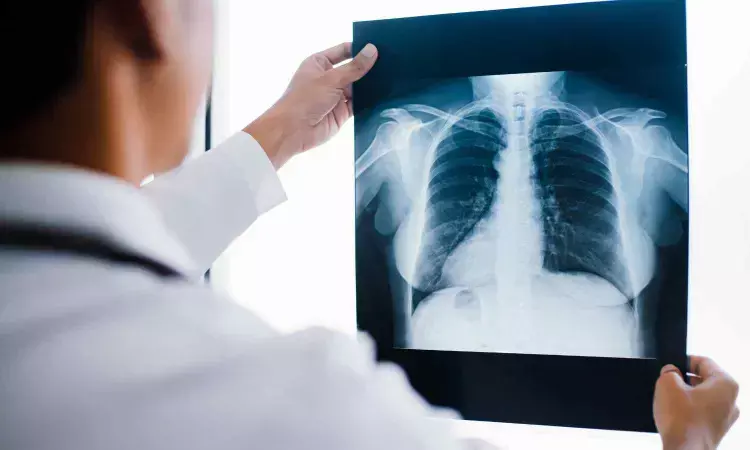- Home
- Medical news & Guidelines
- Anesthesiology
- Cardiology and CTVS
- Critical Care
- Dentistry
- Dermatology
- Diabetes and Endocrinology
- ENT
- Gastroenterology
- Medicine
- Nephrology
- Neurology
- Obstretics-Gynaecology
- Oncology
- Ophthalmology
- Orthopaedics
- Pediatrics-Neonatology
- Psychiatry
- Pulmonology
- Radiology
- Surgery
- Urology
- Laboratory Medicine
- Diet
- Nursing
- Paramedical
- Physiotherapy
- Health news
- Fact Check
- Bone Health Fact Check
- Brain Health Fact Check
- Cancer Related Fact Check
- Child Care Fact Check
- Dental and oral health fact check
- Diabetes and metabolic health fact check
- Diet and Nutrition Fact Check
- Eye and ENT Care Fact Check
- Fitness fact check
- Gut health fact check
- Heart health fact check
- Kidney health fact check
- Medical education fact check
- Men's health fact check
- Respiratory fact check
- Skin and hair care fact check
- Vaccine and Immunization fact check
- Women's health fact check
- AYUSH
- State News
- Andaman and Nicobar Islands
- Andhra Pradesh
- Arunachal Pradesh
- Assam
- Bihar
- Chandigarh
- Chattisgarh
- Dadra and Nagar Haveli
- Daman and Diu
- Delhi
- Goa
- Gujarat
- Haryana
- Himachal Pradesh
- Jammu & Kashmir
- Jharkhand
- Karnataka
- Kerala
- Ladakh
- Lakshadweep
- Madhya Pradesh
- Maharashtra
- Manipur
- Meghalaya
- Mizoram
- Nagaland
- Odisha
- Puducherry
- Punjab
- Rajasthan
- Sikkim
- Tamil Nadu
- Telangana
- Tripura
- Uttar Pradesh
- Uttrakhand
- West Bengal
- Medical Education
- Industry
AI based chest CT images accurate in predicting lung function of COPD patients: Study

A new study published in the International Journal of Chronic Obstructive Pulmonary Disease revealed that machine learning models built on chest CT imaging may transform the way chronic obstructive pulmonary disease (COPD) is diagnosed and graded. This study developed an artificial intelligence (AI) system that leverages CT scans to deliver rapid and accurate assessments, potentially offering a practical alternative for patients unable to undergo conventional pulmonary function testing during the acute phase of the disease.
The retrospective study from December 2017 to June 2023, analyzed medical data from 173 COPD patients and 176 healthy controls. By applying deep learning segmentation modules, the team was able to automatically extract imaging features from different lung regions, including the parenchyma, airway, pulmonary arteries, and veins.
To refine accuracy, statistical methods such as the Mann–Whitney U-test and the least absolute shrinkage and selection operator (LASSO) were applied to identify the most relevant imaging markers. The machine learning models were trained using a support vector machine (SVM) classifier, tested internally, and further validated with an external dataset of 68 individuals.
For COPD diagnosis, the model achieved an area under the curve (AUC) of 0.981 in the training set and 0.977 in the testing set, both strong indicators of diagnostic reliability. Corresponding accuracy rates were 94.9% and 95.6%, respectively, this suggests that the system could distinguish COPD patients from healthy individuals with exceptional precision.
When applied to severity grading, the model demonstrated slightly lower but still clinically useful performance. The training set produced an AUC of 0.889 with an accuracy of 78.4%, while the testing set achieved an AUC of 0.796 and an accuracy of 71.9%. Although grading accuracy did not reach the same levels as diagnostic performance, this research noted that the results remain valuable for clinical application, especially when traditional lung function tests are impractical.
The findings highlight that automated imaging analysis could serve as a powerful adjunct to conventional COPD diagnosis and monitoring. By using chest CT scans, the AI model can predict lung function parameters and provide a reliable assessment of disease severity without invasive or strenuous testing.
Overall, these findings emphasize that while pulmonary function tests remain the gold standard, this approach has the potential to improve efficiency and accessibility, particularly in acute or resource-limited settings. The research suggested that machine learning–based CT analysis may soon become a critical tool in assisting physicians with earlier diagnosis and more tailored treatment plans for COPD patients.
Source:
Sui, H., Mo, Z., Wei, Y., Shi, F., Cheng, K., & Liu, L. (2025). Diagnosis and severity assessment of COPD based on machine learning of chest CT images. International Journal of Chronic Obstructive Pulmonary Disease, 20, 2853–2867. https://doi.org/10.2147/COPD.S528988
Neuroscience Masters graduate
Jacinthlyn Sylvia, a Neuroscience Master's graduate from Chennai has worked extensively in deciphering the neurobiology of cognition and motor control in aging. She also has spread-out exposure to Neurosurgery from her Bachelor’s. She is currently involved in active Neuro-Oncology research. She is an upcoming neuroscientist with a fiery passion for writing. Her news cover at Medical Dialogues feature recent discoveries and updates from the healthcare and biomedical research fields. She can be reached at editorial@medicaldialogues.in
Dr Kamal Kant Kohli-MBBS, DTCD- a chest specialist with more than 30 years of practice and a flair for writing clinical articles, Dr Kamal Kant Kohli joined Medical Dialogues as a Chief Editor of Medical News. Besides writing articles, as an editor, he proofreads and verifies all the medical content published on Medical Dialogues including those coming from journals, studies,medical conferences,guidelines etc. Email: drkohli@medicaldialogues.in. Contact no. 011-43720751


